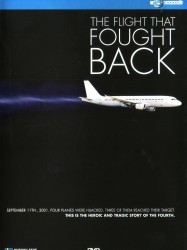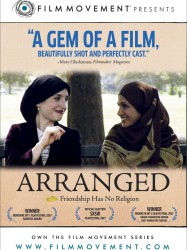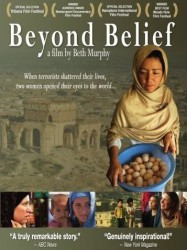Les films ayant le thème "Religion musulmane", triés par recette

Réalisé par Raphael Shore
Origine Etats-Unis
Genres Documentaire
Thèmes Politique, Religion, Le terrorisme, Documentaire sur le droit, Documentaire sur la guerre, Documentaire historique, Documentaire sur la politique, Documentaire sur la religion, Documentaire sur le terrorisme, Politique, Religion musulmane
The movie begins with the following statement: This is a film about radical Islamic terror. A dangerous ideology, fueled by religious hatred. It's important to remember most Muslims are peaceful and do not support terror. This is not a film about them. This is a film about a radical worldview, and the threat it poses to us all, Muslim and non-Muslim alike. The film uses many images from Arab TV, provided by the Middle East Media Research Institute and Palestinian Media Watch.

The Flight That Fought Back (2005)
, 1h30Origine Etats-Unis
Genres Drame, Documentaire
Thèmes Les attentats du 11 septembre 2001, Religion, Le terrorisme, Transport, Aviation, Documentaire sur le droit, Documentaire sur la guerre, Documentaire historique, Documentaire sur la politique, Documentaire sur la religion, Documentaire sur les technologies, Documentaire sur le terrorisme, Politique, Religion musulmane, Film catastrophe, Film de catastrophe aérienne, Détournement d'avion
Acteurs Greg Benson, Pej Vahdat

9/11: Press for Truth (2006)
, 1h25Origine Etats-Unis
Genres Documentaire
Thèmes Les attentats du 11 septembre 2001, Religion, Le terrorisme, Transport, Aviation, Documentaire sur le droit, Documentaire sur la guerre, Documentaire historique, Documentaire sur la politique, Documentaire sur la religion, Documentaire sur les technologies, Documentaire sur le terrorisme, Politique, Religion musulmane, Dans un avion, Film catastrophe, Film de catastrophe aérienne, Détournement d'avion

The Cats of Mirikitani (2006)
, 1h14Genres Documentaire
Thèmes Les attentats du 11 septembre 2001, La prison, Le racisme, Religion, Le terrorisme, Transport, Aviation, Documentaire sur l'art, Documentaire sur la discrimination, Documentaire sur le droit, Documentaire sur la guerre, Documentaire historique, Documentaire sur une personnalité, Documentaire sur la politique, Documentaire sur la religion, Documentaire sur les technologies, Documentaire sur le terrorisme, Politique, Religion musulmane, Documentaire sur la Seconde Guerre mondiale, Film catastrophe, Film de catastrophe aérienne, Détournement d'avion
In 2001 Japanese American painter, Jimmy Mirikitani (born Tsutomu Mirikitani), and over 80 years old, was living on the streets of lower Manhattan. Filmmaker, Linda Hattendorf, took an interest and began
 , 1h38
, 1h38Origine Etats-Unis
Genres Documentaire
Thèmes Religion, Le terrorisme, Documentaire sur le droit, Documentaire sur la guerre, Documentaire historique, Documentaire sur la politique, Documentaire sur la religion, Documentaire sur le terrorisme, Politique, Religion musulmane
Islam: What the West Needs to Know argues that Islam is a violent religion bent on world domination. The documentary uses passages from the canonical texts of Islam as its source material. It is presented in six parts:

Making of (2006)
, 1h55Réalisé par Nouri Bouzid
Genres Drame, Policier
Thèmes Religion, Religion musulmane
Acteurs Lotfi Abdelli, Fatma Ben Saïdane, Afef Ben Mahmoud, Lotfi Dziri, Helmi Dridi, Dorra Zarrouk
Bahta, chômeur et amateur de break dance âgé de 25 ans, est un personnage mal dans sa peau mais plein d'humour face aux déboires de sa vie. Un jour, il choisit de se déguiser en policier pour railler les « Tunisiens moyens résignés à vivre petitement ». Recherché, il est caché par un groupe islamiste qui tente de le transformer en kamikaze.

The Making of a Martyr (2006)
Origine Canada
Genres Documentaire
Thèmes Afrique post-coloniale, Religion, Le terrorisme, Documentaire sur le droit, Documentaire sur la guerre, Documentaire historique, Documentaire sur une personnalité, Documentaire sur la politique, Documentaire sur la religion, Documentaire sur le terrorisme, Politique, Religion juive, Religion musulmane

Takva (2006)
Genres Drame
Thèmes Religion, Religion musulmane
Acteurs Erkan Can, Fatima Adoum, Engin Günaydın, Murat Cemcir
Humble and introvert Muharrem lives in a solitary and meager existence of a prayer and sexual abstinence adhering strictly to the most severe Islamic doctrines.His extraordinary devotion attracts the attention of the leader of a rich and powerful Istanbul religious group and he offers him an administrative post as a rent collector for their numerous properties. Muharrem's new job throws him into the modern outside world he has successfully avoided for so long. He soon witnesses conflict attitude toward alcohol consumption and goodwill.He notices that he himself has become proud, domineering and even dishonest.To make matters worse, Muharrem's inner peace is unnerved by the tormenting image of seductive woman who tempts him in his dreams,both night and day.With the balance of his devotion now upset,his fear of God begins to eat away at his senses.

Det svider i hjärtat (2007)
, 1h15Genres Documentaire
Thèmes Religion, Le terrorisme, Documentaire sur le droit, Documentaire sur la guerre, Documentaire historique, Documentaire sur la politique, Documentaire sur la religion, Documentaire sur le terrorisme, Politique, Religion musulmane

Arranged (2007)
, 1h30Origine Etats-Unis
Genres Drame, Thriller, Comédie, Action, Romance
Thèmes Religion, Religion juive, Religion musulmane
Acteurs Zoe Lister-Jones, Daniel London, John Rothman, Marcia Jean Kurtz, Doris Belack, Arian Moayed
The film centers on two young women — one an Orthodox Jew, the other a devout Muslim — who meet and become friends as first-year teachers at a public school in Brooklyn. Over the course of the year they learn that they share much in common, not least of which is that they are both going through arranged marriages.

Beyond Belief (2007)
, 1h37Réalisé par Beth Murphy
Origine Etats-Unis
Genres Documentaire
Thèmes Les attentats du 11 septembre 2001, Religion, Le terrorisme, Transport, Aviation, Documentaire sur le droit, Documentaire sur la guerre, Documentaire historique, Documentaire sur une personnalité, Documentaire sur la politique, Documentaire sur la religion, Documentaire sur les technologies, Documentaire sur le terrorisme, Politique, Religion musulmane, Film catastrophe, Film de catastrophe aérienne, Détournement d'avion
 , 49minutes
, 49minutesOrigine Espagne
Genres Documentaire
Thèmes Religion, Documentaire historique, Documentaire sur la religion, Religion musulmane
Du VIII au XV siècle, à l’époque de l’Espagne musulmane, une grande quantité de textes scientifiques furent produits. Quand les musulmans quittèrent l’Espagne ils emportèrent de nombreux manuscrits. Aujourd’hui, nous pouvons les retrouver disséminés dans des bibliothèques de particuliers, au long de la Route des Caravanes, au Maroc, en Mauritanie et au Mali. De Tolède à Tombouctou, ce documentaire suit leurs traces. Le protagoniste, Ismael Diadié Haidara, propriétaire de la bibliothèque Al Andalus de Tombouctou, a passé des années à essayer de récupérer les manuscrits familiaux et, avec eux, son passé Al Andalous.
 , 1h10
, 1h10Genres Documentaire
Thèmes L'enfance, Religion, Documentaire sur une personnalité, Documentaire sur la religion, Religion musulmane
Quatre orphelins ouïghours vivent dans un orphelinat de la province de Xinjiang. Leur rêve : devenir funambules. Ils commencent à apprendre cet art, mais leur entraîneur les déclare inaptes. Même le plus doué est rejeté. Un an plus tard, un autre entraîneur arrive à l’orphelinat. Sa patience transforme l’échec en réussite. Ces enfants vivent sur un fil métaphorique, cherchant leur équilibre entre identité ouïghour et Chine communiste, dans un État qui veut les façonner et leur interdit de pratiquer l’Islam. Le premier film sur la politique religieuse dans la province de Xinjiang.

Allah Made Me Funny (2008)
, 1h22Réalisé par Andrea Kalin
Origine Etats-Unis
Genres Comédie, Documentaire
Thèmes La musique, Religion, Documentaire sur la musique, Documentaire sur une personnalité, Documentaire sur la religion, Musique, Religion musulmane
Acteurs Azhar Usman

Fitna (2008)
, 17minutesGenres Documentaire
Thèmes Religion, Le terrorisme, Documentaire sur le droit, Documentaire sur la guerre, Documentaire historique, Documentaire sur la politique, Documentaire sur la religion, Documentaire sur le terrorisme, Politique, Religion musulmane
The film shows a selection of Suras from the Qur'an, interspersed with newspaper clippings and media clips with The Arabian Dance and Åses død as an underscore.
 Connexion
Connexion